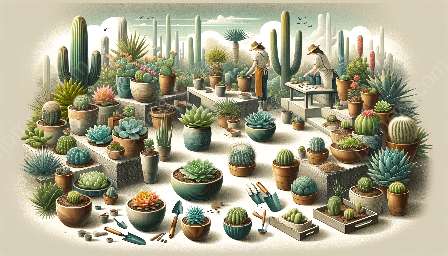Succulents and cacti are popular choices for many gardeners due to their unique shapes and ability to thrive in arid environments. However, these plants are not immune to pests and diseases that can impact their health and overall appearance. By understanding the common culprits and how to address them, you can maintain a robust and vibrant succulent and cacti garden.
The Importance of Identifying Pests and Diseases
Before delving into specific pests and diseases, it is essential to understand the significance of early detection and proper identification. Succulents and cacti are known for their hardy nature, but certain issues can quickly escalate if left unchecked, leading to irreversible damage or even death of the plant.
Regular monitoring of your garden for any signs of infestation or disease is crucial for prompt intervention and control. Identifying the symptoms and characteristics of common pests and diseases will equip you with the knowledge to take timely preventive and remedial actions.
Common Pests Affecting Succulents and Cacti
1. Mealybugs: Mealybugs are small, soft-bodied insects that often appear as white, cottony masses on the plant. They feed on plant juices, causing stunted growth and discoloration. Control measures include spraying with insecticidal soap or neem oil.
2. Spider Mites: These tiny arachnids can cause stippling and webbing on succulents and cacti, leading to weakened and discolored foliage. Regularly misting the plants and using predatory mites or insecticidal soap can help manage spider mite infestations.
3. Scale Insects: Scale insects are notorious for their armored appearance and relentless feeding on plant sap. They can weaken the host plant and excrete honeydew, leading to sooty mold formation. Pruning heavily infested areas and applying horticultural oil are effective control methods.
4. Aphids: These soft-bodied insects can cluster on the new growth of succulents and cacti, causing leaf distortion and wilting. Insecticidal soap or a strong stream of water can help dislodge and manage aphid populations.
Common Diseases Affecting Succulents and Cacti
1. Root Rot: Overwatering and poorly draining soil can result in root rot, characterized by soggy, discolored roots. To prevent and mitigate root rot, ensure proper soil drainage and allow the soil to dry out between watering.
2. Fungal Infections: Various fungal diseases, such as powdery mildew and leaf spot, can affect succulents and cacti, manifesting as powdery growth or dark spots on the plant surfaces. Increasing air circulation and using fungicidal treatments can help manage fungal infections.
3. Bacterial Rot: Bacterial rot can cause mushy, foul-smelling areas on the plant, often as a result of poor sanitation practices or wounds from handling. Pruning affected areas and maintaining clean gardening tools can aid in preventing bacterial rot.
Preventing and Treating Pests and Diseases
1. Cultural Practices: Maintaining proper watering, adequate sunlight exposure, and well-draining soil is fundamental in preventing both pests and diseases. Avoid overfeeding and overcrowding of plants to minimize stress and susceptibility.
2. Natural Predators: Introducing beneficial predators, such as ladybugs and predatory mites, can help keep pest populations in check without resorting to chemical interventions.
3. Quarantine and Inspection: When acquiring new succulents and cacti, always isolate them from your existing collection and conduct thorough inspections to prevent introducing potential pests or diseases.
4. Integrated Pest Management (IPM): Employing a combination of cultural, biological, and chemical control methods as part of an IPM strategy can effectively manage pests and diseases while minimizing environmental impact.
Conclusion
By familiarizing yourself with the common pests and diseases affecting succulents and cacti, you can proactively protect your garden and ensure the continued health and beauty of your beloved plants. Implementing preventive measures, practicing vigilant monitoring, and utilizing appropriate treatments will contribute to a thriving succulent and cacti garden that brings joy and satisfaction to any gardener.
















